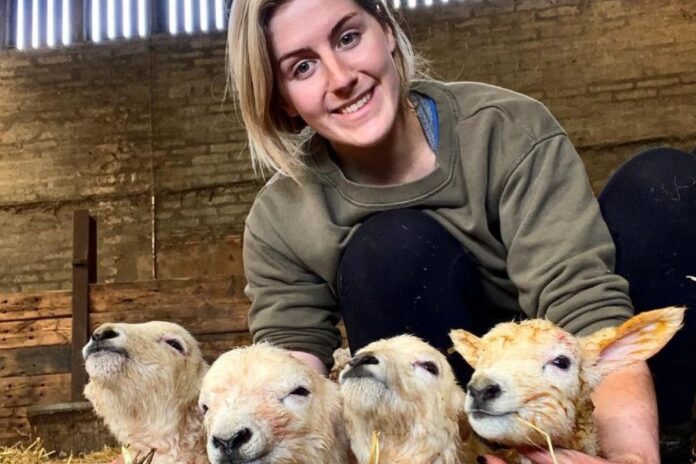In this week’s sheep segment, That’s Farming talks to Katrina Mcarthur, a 25-year-old fourth-generation Scottish sheep farmer. We discuss everything from her the operation of her home farm to lambing season and everything in between.
Life is a juggling act for Katrina Mcarthur, a sheep farmer, livestock fieldsperson with Aberdeen and Northern Marts and self-employed freelance agricultural journalist.
Her family farm comprises 160-strong cows, 25 replacement heifers and 750 sheep. In addition, the Macarthurs produce 250-acres of spring barley and oats for malting and milling.
Her grandparents took on the secure tenancy of their home farm in 1965, and the family purchased a 550-acre unit in the 1970s, followed by a term tenancy on a third unit.
Scottish Sheep Farmer
The farm is located 6 miles from Nairn, which lies along the scenic Moray coast. In total, the farm comprises 1,000 acres, of which 550 are owned. The home farm, located in Newton of Budgate, is under a secure tenancy.
The family farm has always been home to breeding sheep, with maximum numbers reaching 1,100 breeding ewes.
Katrina farms in partnership alongside her parents and two sisters and family members run the enterprise, with additional help from farm worker, Andy Hay.
The Mcarthur family established the Budgate Flock as a breeding flock, which now comprises Scotch Mule, Texel-cross, pedigree Texel and pedigree Blue Texels.
“We use our own home-bred Texel tups, as well as home-bred Blue Texels. We buy in Beltex-Charollais tups,” she told That’s Farming.
“In the past, we run Suffolk tups over the Texel-cross ewes, but we found they did not produce the same carcass quality.”
Katrina believes Texels and cross-bred tups have “excellent” carcass quality. She claims lambs are vigorous, up on their feet and suckling “quickly”.
“We introduced Blue Texels to our hoggets for ease of lambing. The Texel tups over the Scotch Mule ewes produce an ideal yet shapely female replacement.”
“I do a bit of everything on the farm. Lambing is probably one of my main responsibilities, and looking after my own pedigree Blue Texel flock throughout the year. I help with dosing, vaccinating etc., in the summer months.”

Expanding the flock
Katrina follows a system which involves buying Scotch Mule gimmers, which are tupped to a Texel to produce her own Texel-Mule ewe.
“We keep a closed flock of pure Texels and just try to improve quality by buying in one or two main stock tups purchased from premier sales,” Katrina explains to That’s Farming.
Furthermore, the Texel tups they use on the commercial flock are home-bred.
Lambing commences in the first week of February with pedigree ewes and commercials from April 1st each year onwards.
They lamb all pedigree ewes, and the commercial flock, comprising gimmers and hoggets, inside.
In comparison, ewes carrying twins lamb outside, while triplets and singles lamb inside at night but are outside during the day.
The Macarthurs house sheep in one main shed and a polytunnel. They utilise cameras to assist with lambing and have fitted five cameras throughout the shed.
“We think they are excellent, and we could not be without them now for lambing and calving.”
“We lamb the pedigree ewes early so we can produce tup lambs suitable for using later that year or for selling.”
“The commercials lamb from April onwards because the weather is usually kinder, and the grass starts to grow. We also have more shed space available in April as we have sold progeny from the spring calving herd.”
To achieve a compact lambing period, Katrina aims to have ewes in the best possible condition, which she describes as “fit, not fat”.
In addition to this, they sometimes use teasers with the hoggets and sponge pedigree ewes.
“This year, the mules scanned at 210%, Texel-cross ewes were 198%, Texel-cross and Mule gimmers were 177%, and Mule hoggets and Texel-cross hoggets were 125%.”

Farming with passion
She believes the “unrivalled and unprecedented heartache” involved in farming is the most challenging aspect.
“You try your best and put your all into the stock, and you can still end up with disasters. The poor prices we receive are hard to take as well, especially with the high costs involved.”
“I am most passionate about livestock because you cannot beat the satisfaction of producing your own stock. I like working with the stock and seeing them thrive.”
The family are members of the British Limousin Cattle Society, British Texel Society, Blue Texel Sheep Society, and various organisations, shows and groups throughout Scotland.
“My dad has been showing cattle and sheep since the 1980s and has exhibited at shows and events all over the UK. We have not done much in the last few years but are hoping to get back to the show ring this year with sheep.”

Journey into sheep farming
She believes that to be a successful sheep farmer, you must “hold your head high when it all goes wrong”.
Katrina recommends putting in the work and the hours, especially at lambing time to get all lambs on the ground and off to a good start in life.
Her advice to young, aspiring sheep farmers is to “stick in, even on the bad days and not be afraid to ask for help and advice”.
For the future, Katrina plans to increase her Blue Texel flock to 20 ewes and improve quality by introducing some new female lines.
In addition to this, she also plans to purchase a new stock tup this year.
She concludes, “farming is in my blood, and I would not be anywhere without it. In years to come, I hope that my flock is still going strong and producing quality stock for sales.”
To share your story like this Scottish sheep farmer, email – [email protected]
See more sheep farming profiles.





